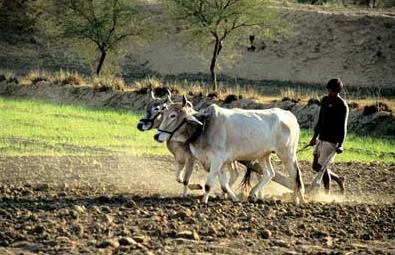GEOGRAPHICAL ORIGIN. Groundnut (Arachis hypogaea L.)is believed to be the native of Brazil to Peru, Argentina and Ghana, from where it was introduced into Jamaica, Cuba and other West Indies islands. The plant was introduced by Portuguese into Africa from where it was introduced into North America. It was introduced into India during the first half of the sixteenth century from one of the Pacific islands of China, where it was introduced earlier from either central America or South America.
ECONOMIC IMPORTANCE. The oil content of the seed varies from 44 to 50 per cent, depending on the varieties and agronomic conditions. Groundnut oil is an edible oil. It finds extensive use as a cooking medium both as refined oil and Vanaspati Ghee. It is also used in soap making, and manufactoring cosmectics and lubricants, olein stearin and their salts. Kernels are also eaten raw, roasted or sweetened. They are rich in protein and vitamins A, B and some members of B2 group. Their calorific value is 349 per 100 grammes. The H.P.S. type of groundnut kernels are exported to foreign contries. The residual oilcake contains 7 to 8 per cent of N, 1.5 per cent of P 2O5 and 1.2 per cent of K2O and is used as a fertilizer. It is an important protein suppliment in cattle and poultry rations. It is also consumed as confectionary product. The cake can be used for manufacturing artificial fibre. The haulms (plant stalks) are fed ( green, dried or silaged) to livestock. Groundnut shell is used as fuel for manufacturing coarse boards, corksubstitutes etc. Groundnut is also of value as rotation crop. Being a legume with root nodules, it can synthesise atmospheric nitrogen and therefore improve soil fertility.
BOTANICAL DESCRIPTION. Groundnut (Archis hypogaea L.) is a member of sub-family, Papilionaceae of the family Leguminosae. Archis hypogaea L. consists of two subspecies each containing two botanical varieties.
ECONOMIC IMPORTANCE. The oil content of the seed varies from 44 to 50 per cent, depending on the varieties and agronomic conditions. Groundnut oil is an edible oil. It finds extensive use as a cooking medium both as refined oil and Vanaspati Ghee. It is also used in soap making, and manufactoring cosmectics and lubricants, olein stearin and their salts. Kernels are also eaten raw, roasted or sweetened. They are rich in protein and vitamins A, B and some members of B2 group. Their calorific value is 349 per 100 grammes. The H.P.S. type of groundnut kernels are exported to foreign contries. The residual oilcake contains 7 to 8 per cent of N, 1.5 per cent of P 2O5 and 1.2 per cent of K2O and is used as a fertilizer. It is an important protein suppliment in cattle and poultry rations. It is also consumed as confectionary product. The cake can be used for manufacturing artificial fibre. The haulms (plant stalks) are fed ( green, dried or silaged) to livestock. Groundnut shell is used as fuel for manufacturing coarse boards, corksubstitutes etc. Groundnut is also of value as rotation crop. Being a legume with root nodules, it can synthesise atmospheric nitrogen and therefore improve soil fertility.
BOTANICAL DESCRIPTION. Groundnut (Archis hypogaea L.) is a member of sub-family, Papilionaceae of the family Leguminosae. Archis hypogaea L. consists of two subspecies each containing two botanical varieties.

